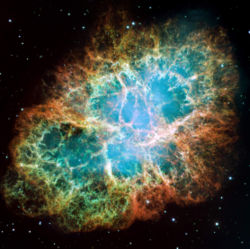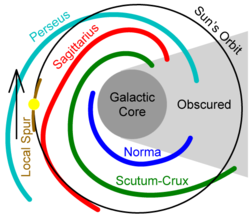Astronomy
Template:Portal Astronomy (Greek: αστρονομία = άστρον + νόμος, astronomia = astron + nomos, literally, "law of the stars") is the celestial science, the study of everything, including the stars, planets, comets, and galaxies, that originates outside the Earth's atmosphere. (e.g., auroras and cosmic background radiation). Astronomers consider the evolution, physics, chemistry, and motion of these celestial bodies, as well as the formation and development of the universe.
Astronomy is one of the oldest sciences. Astronomers of early civilizations performed methodical observations of the night sky, and astronomical artifacts have been found from much earlier periods. However, it required the invention of the telescope before astronomy developed into a modern science.
Since the 20th century, the field of professional astronomy has split into observational astronomy and theoretical astrophysics. Observational astronomy is concerned with acquiring data, which involves building and maintaining instruments, as well as processing the results. Theoretical astrophysics is concerned with ascertaining the observational implications of computer or analytic models. The two fields complement each other, with theoretical astronomy seeking to explain the observational results. Astronomical observations can be used to test fundamental theories in physics, such as general relativity.
Historically, amateur astronomers have contributed to many important astronomical discoveries, and astronomy is one of the few sciences where amateurs can still play an active role, especially in the discovery and observation of transient phenomena.
Modern astronomy is not to be confused with astrology, the belief system that claims human affairs are correlated with the positions of celestial objects. Although the two fields share a common origin, most thinkers in both fields believe they are now distinct.[1]
History
In early times, astronomy only comprised the observation and predictions of the motions of the naked-eye objects. In some locations, such as Stonehenge, early cultures assembled massive artifacts that likely had some astronomical purpose. In addition to their ceremonial uses, these observatories could be employed to determine the seasons, an important factor in knowing when to plant crops, as well as the length of the year.[2]
As civilizations developed, most notably Babylonia, Egypt, ancient Greece, India, and China, astronomical observatories were assembled and ideas on the nature of the universe began to be explored. Early ideas on the motions of the planets were developed, and the nature of the Sun, Moon and the Earth in the universe were explored philosophically. These included speculations on the spherical nature of the Earth and Moon, and the rotation and movement of the Earth through the heavens.
A few notable astronomical discoveries were made prior to the application of the telescope. For example, the obliquity of the ecliptic was estimated as early as 1,000 B.C by the Chinese. The Chaldeans discovered that eclipses recurred in a repeating cycle known as a saros. In the second century B.C., the size and distance of the Moon were estimated by Hipparchus.
During the Middle Ages, observational astronomy was mostly stagnant in medieval Europe until the 13th century. However, observational astronomy flourished in the Persian Empire and other parts of the Islamic world. Islamic astronomers introduced many names that are now used for individual stars.[3][4]
Scientific revolution

During the Renaissance, Nicolaus Copernicus proposed a heliocentric model of the Solar System. His work was defended, expanded upon, and corrected by Galileo Galilei and Johannes Kepler. Galileo added the innovation of using telescopes to enhance his observations.
Kepler was the first to devise a system that described correctly the details of the motion of the planets with the Sun at the center. However, Kepler did not succeed in formulating a theory behind the laws he wrote down. It was left to Newton's invention of celestial dynamics and his law of gravitation to finally explain the motions of the planets. Newton also developed the reflecting telescope.
Further discoveries paralleled the improvements in size and quality of the telescope. More extensive star calatogues were produced by Lacaille. The astronomer William Herschel made an extensive catalog of nebulosity and clusters, and in 1781 discovered the planet Uranus, the first new planet found. The distance to a star was first announced in 1838 when the parallax of 61 Cygni was measured by Friedrich Bessel.
During the nineteenth century, attention to the three body problem by Euler, Clairaut and D'Alembert led to more accurate predictions about the motions of the Moon and planets. This work was further refined by Lagrance and Laplace, allowing the masses of the planets and moons to be estimated from their perturbations.
Significant advances in astronomy came about with the introduction of new technology, including the spectroscope and photography. Fraunhofer discovered about 600 bands in the spectrum of the Sun in 1814-15, which, in 1859, Kirchhoff ascribed to the presence of different elements. Stars were proven to be similar to Earth's own sun, but with a wide range of temperatures, masses, and sizes.[3]
The existence of Earth's galaxy, the Milky Way, as a separate group of stars was only proved in the 20th century, along with the existence of "external" galaxies, and soon after, the expansion of the universe, seen in the recession of most galaxies from us. Modern astronomy has also discovered many exotic objects such as quasars, pulsars, blazars and radio galaxies, and has used these observations to develop physical theories which describe some of these objects in terms of equally exotic objects such as black holes and neutron stars. Physical cosmology made huge advances during the 20th century, with the model of the Big Bang heavily supported by the evidence provided by astronomy and physics, such as the cosmic microwave background radiation, Hubble's law, and cosmological abundances of elements.
Astronomical observations

In Babylon and ancient Greece, astronomy consisted largely of astrometry, measuring the positions of stars and planets in the sky. Later, the work of astronomers Kepler and Newton led to the development of celestial mechanics, and astronomy focused on mathematically predicting the motions of gravitationally interacting celestial bodies. This was applied to solar system objects in particular. Today, the motions and positions of objects are more easily determined, and modern astronomy concentrates on observing and understanding the physical nature of celestial objects.
Methods of data collection
In astronomy, information is mainly received from the detection and analysis of light and other forms of electromagnetic radiation. Other cosmic rays are also observed, and several experiments are designed to detect gravitational waves in the near future. Neutrino detectors have been used to observe solar neutrinos, and neutrino emissions from supernovae have also been detected.[5][6]
A traditional division of astronomy is given by the region of the electromagnetic spectrum observed. At the low frequency end of the spectrum, radio astronomy detects radiation of millimeter to dekameter wavelength. The radio telescope receivers are similar to those used in radio broadcast transmission but much more sensitive. Microwaves form the millimeter end of the radio spectrum and are important for studies of the cosmic microwave background radiation.
Infrared astronomy and far infrared astronomy deal with the detection and analysis of infrared radiation (wavelengths longer than red light). The most common tool is the telescope but using a detector which is sensitive to the infrared. Infrared radiation is heavily absorbed by atmospheric water vapor, so infrared observatories have to be located in high, dry places or in outer space. Space telescopes in particular avoid atmospheric thermal emission, atmospheric opacity, and the negative effects of astronomical seeing at infrared and other wavelengths. Infrared is particularly useful for observation of galactic regions cloaked by dust.
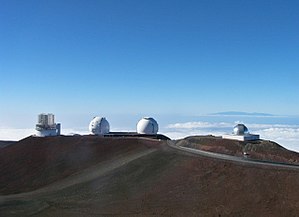
Historically, most astronomical data has been collected through optical astronomy. This is the portion of the spectrum that uses optical components (mirrors, lenses, CCD detectors and photographic films) to observe light from near infrared to near ultraviolet wavelengths. Visible light astronomy (using wavelengths that can be detected with the eyes, about 400 - 700 nm) falls in the middle of this range. The most common tool is the telescope, with electronic imagers and spectrographs.
More energetic sources are observed and studied in high-energy astronomy, which includes X-ray astronomy, gamma ray astronomy, and extreme UV (ultraviolet) astronomy, as well as studies of neutrinos and cosmic rays.
Optical and radio astronomy can be performed with ground-based observatories, because the Earth's atmosphere is transparent at the wavelengths being detected. The atmosphere is opaque at the wavelengths of X-ray astronomy, gamma-ray astronomy, UV astronomy and (except for a few wavelength "windows") far infrared astronomy, so observations must be carried out mostly from balloons or space observatories. Powerful gamma rays can, however be detected by the large air showers they produce, and the study of cosmic rays can also be regarded as a branch of astronomy.[7]
Planetary astronomy has benefited from direct observation in the form of spacecraft and sample return missions. These include fly-by missions with remote sensors, landing vehicles that can perform experiments on the surface materials, impactors that allow remote sensing of buried materials, and sample return missions that allow direct laboratory examination.
Astrometry and celestial mechanics
One of the oldest fields in astronomy, and in all of science, is the measurement of the positions of celestial objects in the sky. Historically, accurate knowledge of the positions of the Sun, Moon, planets and stars has been essential in celestial navigation.
Careful measurement of the positions of the planets has led to a solid understanding of gravitational perturbations and an ability to determine past and future positions of the planets with great accuracy, a field known as celestial mechanics. More recently the tracking of near-Earth objects will allow for predictions of close encounters, and potential collisions, with the Earth.[8]
The measurement of stellar parallax of nearby stars provides a fundamental baseline in the cosmic distance ladder that is used to measure the scale of the universe. Parallax measurements of nearby stars provides an absolute baseline for the properties of more distant stars, because their properties can be compared. Measurements of radial velocity and proper motion show the kinematics of these systems through the Milky Way galaxy. Astrometric results are also used to measure the distribution of dark matter in the galaxy.[9]
During the 1990s, the astrometric technique of measuring the stellar wobble led to the discovery of large extrasolar planets orbiting nearby stars.[10]
Interdisciplinary studies
Astronomy has developed significant interdisciplinary links with other major scientific fields. These include:
- Astrophysics: the study of the physics of the universe, including the physical properties (luminosity, density, temperature, chemical composition) of astronomical objects.
- Astrobiology: the study of the advent and evolution of biological systems in the universe.
- Archaeoastronomy: the study of ancient or traditional astronomies in their cultural context, utilising archaeological and anthropological evidence.
- Astrochemistry: the study of the chemicals found in outer space, usually in molecular gas clouds, and their formation, interaction and destruction. As such, it represents an overlap of the disciplines of astronomy and chemistry.
Astronomical objects
Solar astronomy
The most frequently studied star is the Sun, a typical main-sequence dwarf star of stellar class G2 V, and about 4.6 Gyr in age. The Sun is not considered a variable star, but it does undergo periodic changes in activity known as the sunspot cycle. This is an 11-year fluctuation in sunspot numbers. Sunspots are regions of lower than average temperature that are associated with intense magnetic activity.[11]
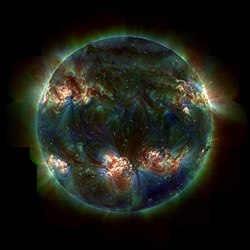
The Sun has steadily increased in luminosity over the course of its life, increasing by 40% since it first became a main-sequence star. The Sun has also undergone periodic changes in luminosity that can have a significant impact on the Earth. The Maunder minimum, for example, is believed to have caused the Little Ice Age phenomenon during the Middle Ages.[12]
The visible outer surface of the Sun is called the photosphere. Above this layer is a thin region known as the chromosphere. This is surrounded by a transition region of rapidly increasing temperatures, then by the super-heated corona.
At the center of the Sun is the core region, a volume of sufficient temperature and pressure for nuclear fusion to occur. Above the core is the radiation zone, where the plasma conveys the energy flux by means of radiation. The outer layers form a convection zone where the gas material transports energy primarily through physical displacement of the gas. It is believed that this convection zone creates the magnetic activity that generates sun spots.[11]
A solar wind of plasma particles constantly streams outward from the Sun until it reaches the heliopause. This solar wind interacts with the magnetosphere of the Earth to create the Van Allen radiation belts, as well as the aurora where the lines of the Earth's magnetic field descend into the atmosphere.[13]
Planetary science
This astronomical field examines the assemblage of planets, moons, dwarf planets, comets, asteroids, and other bodies orbiting the Sun, as well as extrasolar planets. The solar system has been relatively well-studied, initially through telescopes and then later by spacecraft. This has provided a good overall understanding of the formation and evolution of this planetary system, although many new discoveries are still being made.[14]

The solar system is subdivided into the inner planets, the asteroid belt, and the outer planets. The inner terrestrial planets consist of Mercury, Venus, Earth, and Mars. The outer gas giant planets are Jupiter, Saturn, Uranus and Neptune.[15]
The planets formed from a protoplanetary disk that surrounded the early Sun. Through a process that included gravitational attraction, collision, and accretion, the disk formed clumps of matter that with time became protoplanets. The radiation pressure of the solar wind then expelled most of the unaccreted matter, and only those planets with sufficient mass retained their gaseous atmosphere. The planets continued to sweep up or eject the remaining matter during a period of intense bombardment evidenced by the many impact craters on the Moon. During this period some protoplanets may have collided, the leading hypothesis for how the Moon was formed.[16]
Once a planet reaches sufficient mass, the materials with different densities segregate within its interior during planetary differentiation. This process can form a stony or metallic core surrounded by a mantle and outer surface. The core may include solid and liquid regions, and some planetary cores generate their own magnetic field, which can protect its atmosphere from solar wind stripping.[17]
A planet or moon's interior heat is produced from the collisions that created the body, radioactive materials (e.g. uranium, thorium, and 26Al), or tidal heating. Some planets and moons accumulate enough heat to drive geologic processes such as volcanism and tectonics. Those that accumulate or retain an atmosphere can also undergo surface erosion due to wind or water. Smaller bodies without tidal heating cool more quickly and their geological activity ceases with the exception of impact cratering.[18]
Stellar astronomy
The study of stars and stellar evolution is fundamental to our understanding of the universe. The astrophysics of stars has been determined through observation, theoretical understanding and from computer simulations of the interior.
Star formation occurs in dense regions of dust and gas, known as giant molecular clouds. When destabilized, cloud fragments can collapse under the influence of gravity to form a protostar. A sufficiently dense and hot core region will trigger nuclear fusion and it becomes a main-sequence star.[19]
The characteristics of the resulting star depend primarily on its starting mass. The more massive the star, the greater its luminosity and the more rapidly it expends the hydrogen fuel in its core. Over time this hydrogen fuel is completely converted into helium and the star begins to evolve. Fusion of helium requires a higher core temperature, so the star both expands in size and increases in density at the core. The resulting red giant enjoys a brief life span before the helium fuel is in turn consumed. Very massive stars can also undergo a series of shorter and shorter evolutionary phases as they fuse increasingly heavier elements.
The final fate of the star depends on its mass, with stars of mass greater than 1.4 times the Sun becoming supernovae, while smaller stars will form planetary nebulae and evolve into white dwarfs. The remnant of a supernova is a dense neutron star, or, if the stellar mass was at least three times that of the Sun, a black hole.[20]
Galactic astronomy
Our solar system orbits within the Milky Way, a barred spiral galaxy that is a prominent member of the Local Group of galaxies. It is a rotating mass of gas, dust, stars and other objects, held together by mutual gravitational attraction. As the Earth is located within the dusty outer arms, there are large portions of the Milky Way that are obscured from view.
In the center of the Milky Way is the core region, a bar-shaped bulge with what is believed to be a supermassive black hole at the center. This is surrounded by four primary arms that spiral out from the core. This is a region of active star formation that contains many younger, population II stars. The disk is surrounded by a spheroid halo of older, population I stars, as well as relatively dense concentrations of stars known as globular clusters.[21][22]
Between the stars lies the interstellar medium, a region of sparse matter. In the densest regions, molecular clouds of molecular hydrogen and other elements create star-forming regions. These begin as irregular dark nebulae, which concentrate and collapse (in volumes determined by the Jeans length) to form compact protostars.[23]
As the more massive stars appear, they transform the cloud into an H II region of glowing gas and plasma. The stellar wind and supernova explosions from these stars eventually serve to disperse the cloud, often leaving behind one or more young open clusters of stars. These gradually disperse to join the population of stars in the Milky Way.
Kinematic studies of matter in the Milky Way and other galaxies have demonstrated that there is more mass than can be accounted for by visible matter. A dark matter halo appears to dominate the mass, although the nature of this dark matter remains undetermined.[24]
Galaxies and clusters
The study of objects outside our galaxy is a branch of astronomy concerned with the formation and evolution of Galaxies, their morphology and classification, the examination of active galaxies and the groups and clusters of galaxies. The later is important for the understanding of the large-scale structure of the cosmos.
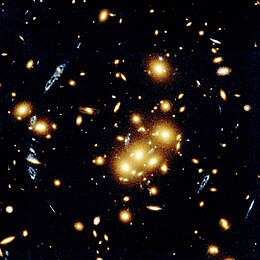
Most galaxies are organized into distinct shapes that allow for classification schemes. They are commonly divided into spiral, elliptical and Irregular galaxies.[25]
As the name suggests, an elliptical galaxy has the cross-sectional shape of an ellipse. The stars move along random orbits with no prefered direction. These galaxies contains little or no interstellar dust, few star-forming regions and generally older stars. Elliptical galaxies are more commonly found at the core of galactic clusters and may be formed through mergers of large galaxies.
A spiral galaxy is organized into a flat, rotating disk, usually with a prominent bulge or bar at the center, and trailing bright arms that spiral outward. The arms are dusty regions of star formation where massive young stars produce a blue tint. Spiral galaxies are typically surrounded by a halo of older stars. Both the Milky Way and the Andromeda Galaxy are spiral galaxies.
Irregular galaxies are chaotic in appearance, and are neither spiral nor elliptical in form. About a quarter of all galaxies are irregular, and their peculiar shape may be the result of gravitational interaction.
An active galaxy is a formation that is emitting a significant amount of its energy from a source other than stars, dust and gas. They are powered by a compact region at the core, usually thought to be a supermassive black hole that is emitting radiation due to infalling material.
A radio galaxy is an active galaxy that is very luminous in the radio portion of the spectrum, and is emitting immense plumes or lobes of gas. Active galaxies that emit high-energy radiation include Seyfert galaxies, Quasars, and Blazars. Quasars are believed to be the most consistently luminous objects in the known universe.[26]
The large-scale structure of the cosmos is represented by groups and clusters of galaxies. This structure is organized in a hierarchy of groupings, with the largest being the superclusters. The collective matter is formed into filaments and walls, leaving large voids in between.[27]
Cosmology
Observations of the large-scale structure of the universe, a branch known as physical cosmology, have provided a deep understanding of the formation and evolution of the cosmos. Fundamental to modern cosmology is the well-accepted theory of the big bang, wherein our universe began at a single point in time and thereafter expanded over the course of 13.7 Gyr to its present condition. The concept of the big bang can be traced back to the discovery of the microwave background radiation in 1965.
In the course of this expansion, the universe underwent several evolutionary stages. In the very early moments, it is theorized that the universe underwent a very rapid cosmic inflation, which homogenized the starting conditions. Thereafter nucleosynthesis produced the elemental abundance of the early universe.
When the first atoms formed space became transparent to radiation; releasing the energy viewed today as the microwave background radiation. The expanding universe then underwent a dark age due to the lack of stellar energy sources.[28]
A hierarchical structure of matter began to form from minute variations in the mass density. Matter accumulated in the densest regions, forming clouds of gas and the earliest stars. These massive stars triggered the reionization process and are believed to have created many of the heavy elements in the early universe.
Gravitational aggregations clustered into filaments, leaving voids in the gaps. Gradually organizations of gas and dust merged to form the first primitive galaxies. Over time these pulled in more matter, and were often organized into groups and clusters of galaxies, then into larger-scale superclusters.[29]
Fundamental to the structure of the universe is the existence of dark matter and dark energy. These are now thought to be the dominant components, forming 96% of the density of the universe. So much effort is being spent to try and understand the physics of these components.[30]
Amateur astronomy
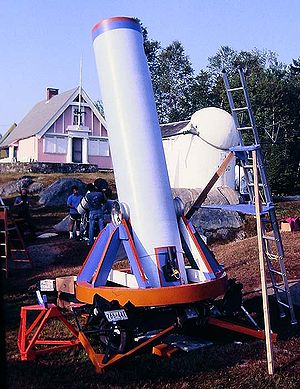
Collectively, amateur astronomers observe a variety of celestial objects and phenomena sometimes with equipment they build themselves. Common targets of amateur astronomers include the Moon, planets, stars, comets, meteor showers, and a variety of deep sky objects such as star clusters, galaxies, and nebulae. One branch of amateur astronomy, amateur astrophotography, involves the taking of photos of the night sky. Many amateurs like to specialise in observing particular objects, types of objects, or types of events which interest them.[31][32]
Most amateurs work at visible wavelengths, but a small minority experiment with wavelengths outside the visible spectrum. This includes the use of infrared filters on conventional telescopes, and also the use of radio telescopes. The pioneer of amateur radio astronomy was Karl Jansky who started observing the sky at radio wavelengths in the 1930s. A number of amateur astronomers use either homemade telescopes or use radio telescopes which were originally built for astronomy research but which are now available to amateurs (e.g. the One-Mile Telescope).[33][34]
Amateur astronomers continue to make scientific contributions to the field of astronomy. Indeed it is one of the few scientific disciplines where amateurs can still make significant contributions. Amateurs can make occultation measurements that are used to refine the orbits of minor planets. They can also discover comets and perform regular observations of variable stars. Improvements in digital technology have allowed amateurs to make impressive advances in the field of astrophotography. [35][36][37]
Major questions in astronomy
Although the scientific discipline of astronomy has made tremendous strides in understanding the nature of the universe and its contents, there remain some important unanswered questions. Answers to these may require the construction of new ground and space-based instruments, and possibly new developments in theoretical and experimental physics.
- Are there Earth-like planets around other stars? Astronomers have found massive stars and disks of debris around other stars. So the existence of smaller, terrestrial planets seems likely.[38]
- Is there other life in the Universe? Especially, is there other intelligent life? If so, what is the explanation for the Fermi paradox? The existence of life elsewhere has important scientific and philosophical implications.[39][40]
- What is the nature of dark matter and dark energy? These dominate the evolution and fate of the cosmos, yet we are still uncertain about their true nature.[41]
- Why did the universe come to be? Why, for example, are the physical constants so finely tuned that they permit the existence of life? What caused the cosmic inflation that produced our homogeneous universe?[42]
See also
Template:Wikiversity Template:Sisterlinks
- Ancient astronomy
- Astronomers and Astrophysicists
- Astronomical observatories
- Astronomy organisations
- Astronomy timelines
- Space science
References
- ↑ Albrecht Unsöld, Bodo Baschek, W.D. Brewer(translator). The New Cosmos: An Introduction to Astronomy and Astrophysics. Springer. ISBN 3-540-67877-8.
- ↑ George Forbes (1909). History of Astronomy (Free e-book from Project Gutenberg). London: Watts & Co..
- ↑ 3.0 3.1 Arthur Berry (1961). A Short History of Astronomy From Earliest Times Through the Nineteenth Century. New York: Dover Publications, Inc..
- ↑ (1999) Michael Hoskin: The Cambridge Concise History of Astronomy. Cambridge University Press. ISBN 0-521-57600-8.
- ↑ Electromagnetic Spectrum (English). NASA. Retrieved on 2006-09-08.
- ↑ G. A. Tammann, F. K. Thielemann, D. Trautmann (2003). Opening new windows in observing the Universe (English). Europhysics News. Retrieved on 2006-08-22.
- ↑ Penston, Margaret J. (2002-08-14). The electromagnetic spectrum (English). Particle Physics and Astronomy Research Council. Retrieved on 2006-08-17.
- ↑ Calvert, James B. (2003-03-28). Celestial Mechanics (English). University of Denver. Retrieved on 2006-08-21.
- ↑ Hall of Precision Astrometry (English). University of Virginia Department of Astronomy. Retrieved on 2006-08-10.
- ↑ Wolszczan, A.; Frail, D. A. (1992). "A planetary system around the millisecond pulsar PSR1257+12". Nature 355: 145 – 147.
- ↑ 11.0 11.1 Johansson, Sverker (2003-07-27). The Solar FAQ (English). Talk.Origins Archive. Retrieved on 2006-08-11.
- ↑ Pogge, Richard W. (1997). The Once & Future Sun (lecture notes). New Vistas in Astronomy. Retrieved on 2005-12-07.
- ↑ D. P. Stern, M. Peredo (2004-09-28). The Exploration of the Earth's Magnetosphere (English). NASA. Retrieved on 2006-08-22.
- ↑ J. F. Bell III, B. A. Campbell, M. S. Robinson (2004). Remote Sensing for the Earth Sciences: Manual of Remote Sensing, 3rd. John Wiley & Sons. Retrieved on 2006-08-23.
- ↑ E. Grayzeck, D. R. Williams (2006-05-11). Lunar and Planetary Science (English). NASA. Retrieved on 2006-08-21.
- ↑ Roberge, Aki (1997-05-05). Planetary Formation and Our Solar System (English). Carnegie Institute of Washington—Department of Terrestrial Magnetism. Retrieved on 2006-08-11.
- ↑ Roberge, Aki (1998-04-21). The Planets After Formation (English). Department of Terrestrial Magnetism. Retrieved on 2006-08-23.
- ↑ (1999) J.K. Beatty, C.C. Petersen, A. Chaikin: The New Solar System, 4th. Cambridge press. ISBN 0-521-64587-5.
- ↑ Stellar Evolution & Death (English). NASA Observatorium. Retrieved on 2006-06-08.
- ↑ (1994) Jean Audouze, Guy Israel: The Cambridge Atlas of Astronomy, 3rd. Cambridge University Press. ISBN 0-521-43438-6.
- ↑ Ott, Thomas (2006-08-24). The Galactic Centre (English). Max-Planck-Institut für extraterrestrische Physik. Retrieved on 2006-09-08.
- ↑ Faulkner, Danny R. (1993). "The Role Of Stellar Population Types In The Discussion Of Stellar Evolution". CRS Quarterly 30 (1): 174-180. Retrieved on 2006-09-08.
- ↑ Hanes, Dave (2006-08-24). Star Formation; The Interstellar Medium (English). Queen's University. Retrieved on 2006-09-08.
- ↑ Van den Bergh, Sidney (1999). "The Early History of Dark Matter". Publications of the Astronomy Society of the Pacific 111: 657-660.
- ↑ Keel, Bill (2006-08-01). Galaxy Classification (English). University of Alabama. Retrieved on 2006-09-08.
- ↑ Active Galaxies and Quasars (English). NASA. Retrieved on 2006-09-08.
- ↑ Zeilik, Michael (2002). Astronomy: The Evolving Universe, 8th. Wiley. ISBN 0-521-80090-0.
- ↑ Hinshaw, Gary (2006-07-13). Cosmology 101: The Study of the Universe (English). NASA WMAP. Retrieved on 2006-08-10.
- ↑ Galaxy Clusters and Large-Scale Structure (English). University of Cambridge. Retrieved on 2006-09-08.
- ↑ Preuss, Paul. Dark Energy Fills the Cosmos (English). U.S. Department of Energy, Berkeley Lab. Retrieved on 2006-09-08.
- ↑ The Americal Meteor Society (English). Retrieved on 2006-08-24.
- ↑ Lodriguss, Jerry. Catching the Light: Astrophotography (English). Retrieved on 2006-08-24.
- ↑ F. Ghigo (2006-02-07). Karl Jansky and the Discovery of Cosmic Radio Waves (English). National Radio Astronomy Observatory. Retrieved on 2006-08-24.
- ↑ Cambridge Amateur Radio Astronomers (English). Retrieved on 2006-08-24.
- ↑ The International Occultation Timing Association (English). Retrieved on 2006-08-24.
- ↑ Edgar Wilson Award (English). Harvard-Smithsonian Center for Astrophysics. Retrieved on 2006-08-24.
- ↑ American Association of Variable Star Observers (English). AAVSO. Retrieved on 2006-08-24.
- ↑ Origins: Are There Other Earth-like Planets? (English). NASA Origins Education Forum. Retrieved on 2006-08-12.
- ↑ Complex Life Elsewhere in the Universe? (English). Astrobiology Magazine. Retrieved on 2006-08-12.
- ↑ The Quest for Extraterrestrial Intelligence (English). Cosmic Search Magazine. Retrieved on 2006-08-12.
- ↑ 11 Physics Questions for the New Century (English). Pacific Northwest National Laboratory. Retrieved on 2006-08-12.
- ↑ Was the Universe Designed? (English). Counterbalance Meta Library. Retrieved on 2006-08-12.
External links
- Astronomy at about.com
- AbsoluteAstronomy.com
- The Amazing Sky
- Astronomy Picture of the Day
- Night Sky Info
- Sky & Telescope publishers
- Southern Hemisphere Astronomy
- Search Engine for Astronomy
- Universe Today for astronomy and space-related news
